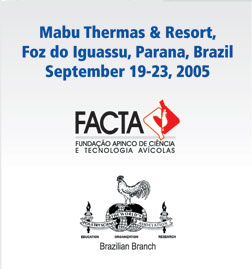Contributed Papers: Oral Presentations
Diagnosis and Epidemiology |
Sequence analysis
of the 18S RNA gene of Isospora belli and identification
of Caryospora-like oocysts
Chaturong Putaporntip, Malee Charoenkorn,
Somchai Jongwutiwes
Department of Parasitology, Faculty of Medicine, Chulalongkorn
University, Bangkok 10330, Thailand; e-mail: fmedcpt@md2.md.chula.ac.th
Isospora belli
is an important coccidian protozoan that parasitizes
both immunocompetent and immunocompromised patients,
especially HIV-1 infected patients with low CD4+ lymphocyte
counts. During 2002-2004, 38 patients infected with
I. belli were identified by examination of 78,743
stool specimens submitted to the parasitology laboratory
of King Chulalongkorn Memorial Hospital in Bangkok.
Isosporiasis patients comprised 35 Thai from diverse
regions of the country and 3 recent immigrants from
Cambodia, Laos and Pakistan. Out of these, 30 were
HIV-positive, 3 received prolonged corticosteroid
therapy for other diseases and 5 immunocompetent individuals.
In order to verify if genetic heterogeneity or cryptic
species occur in Isospora infecting humans, we determined
the morphometry of oocysts from all patients and performed
sequencing analysis of the small subunit ribosomal
RNA gene (SSU rDNA, 18S RNA) spanning 1,680 base pairs
from 26 isolates. Morphometric study of oocysts revealed
that oocyst dimension in this study varied from 17
to 37 (28.3±3.0) mm in length, 8 to 21 (13.5±1.9)
mm in width and the shape index (length by width)
1.3 to 3.3 (2.1±0.3). Although the oocysts
exhibited shape and size variations both within and
among isolates in this study, the shape indices of
all oocysts observed were consistent with that of
I. belli being more than 1.2 (range=1.3-3.3), which
were distinct from those for I. natanlensis and other
species infecting nonhuman mammals (<1.2). Additionally,
we observed oocyst maturation after passage from intestine
from 3 patients, who had not yet taken anti-coccidial
drugs: 2 HIV-infected patients, one of them had relapse,
and an immunocompetent patient presented with chronic
diarrhea. In total 100 oocysts for each isolate were
examined for sporulation every 6 hours under light
microscope using 400x magnification for 20 days. Results
revealed that 27% of oocysts (range=20-33%) underwent
complete sporulation and the duration for generating
2 sporocysts each of which contained 4 sporozoites
was variable ranging from 24 hours to 10 days (3.9±3.4
days)(n= 66). More interestingly, fully sporulated
oocysts having a single sporocyst covering 8 sporozoites,
designated Caryospora-like oocysts, were found in
all 3 isolates representing 9-29% of all mature oocysts
(n=15). Meanwhile, the SSU rDNA sequences revealed
minimal sequence variation containing 2 sequence types.
Thus, no correlation between distinct I. belli strain
and disease severity was observed. Phylogenetic tree
showed that I. belli in this study was within the
same clade as I. ohioensis, I. suis, I. orlovi, I.
felis, Toxoplasma gondii and Sarcocystis sp. In conclusion,
unlike Cryptosporidium infecting humans that comprises
both zoonotic and anthroponotic species, our study
demonstrated that human isosporiasis is caused by
a single species belonging to I. belli based on morphometric
and molecular evidences.
